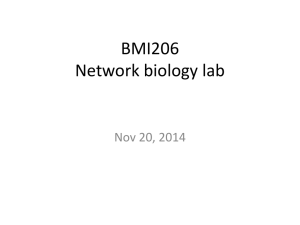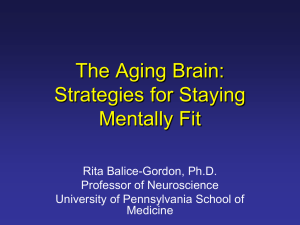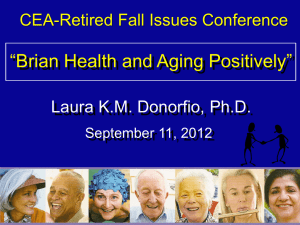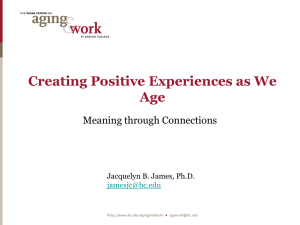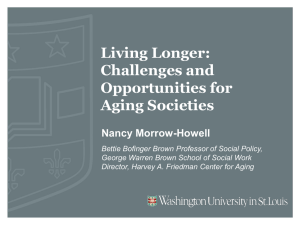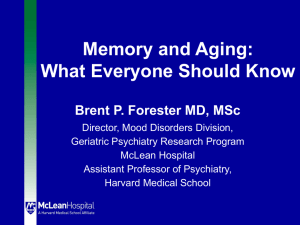The application of genome-wide association studies
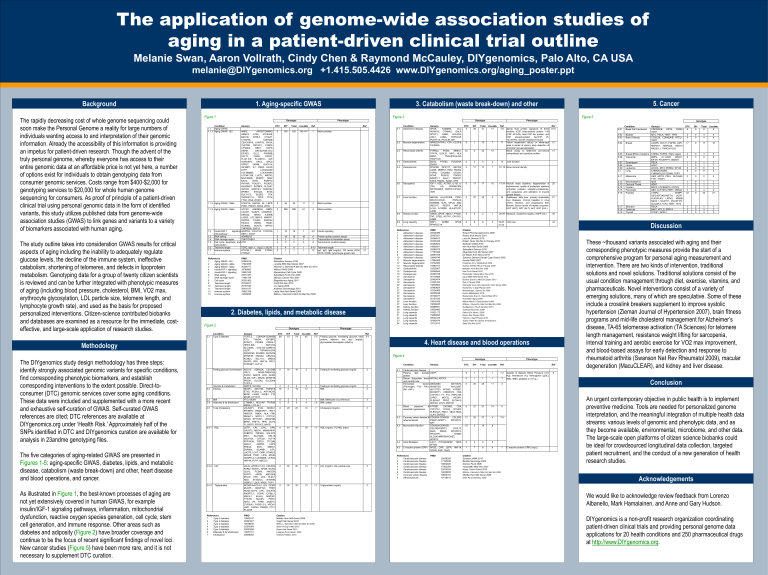
The application of genome-wide association studies of aging in a patient-driven clinical trial outline
Melanie Swan, Aaron Vollrath, Cindy Chen & Raymond McCauley, DIYgenomics, Palo Alto, CA USA melanie@DIYgenomics.org +1.415.505.4426 www.DIYgenomics.org/aging_poster.ppt
Background
The rapidly decreasing cost of whole genome sequencing could soon make the Personal Genome a reality for large numbers of individuals wanting access to and interpretation of their genomic information. Already the accessibility of this information is providing an impetus for patient-driven research. Though the advent of the truly personal genome, whereby everyone has access to their entire genomic data at an affordable price is not yet here, a number of options exist for individuals to obtain genotyping data from consumer genomic services. Costs range from $400-$2,000 for genotyping services to $20,000 for whole human genome sequencing for consumers. As proof of principle of a patient-driven clinical trial using personal genomic data in the form of identified variants, this study utilizes published data from genome-wide association studies (GWAS) to link genes and variants to a variety of biomarkers associated with human aging.
The study outline takes into consideration GWAS results for critical aspects of aging including the inability to adequately regulate glucose levels, the decline of the immune system, ineffective catabolism, shortening of telomeres, and defects in lipoprotein metabolism. Genotyping data for a group of twenty citizen scientists is reviewed and can be further integrated with phenotypic measures of aging (including blood pressure, cholesterol, BMI, VO2 max, erythrocyte glycosylation, LDL particle size, telomere length, and lymphocyte growth rate), and used as the basis for proposed personalized interventions. Citizen-science contributed biobanks and databases are examined as a resource for the immediate, costeffective, and large-scale application of research studies.
Methodology
The DIYgenomics study design methodology has three steps: identify strongly associated genomic variants for specific conditions, find corresponding phenotypic biomarkers, and establish corresponding interventions to the extent possible. Direct-toconsumer (DTC) genomic services cover some aging conditions.
These data were included and supplemented with a more recent and exhaustive self-curation of GWAS. Self-curated GWAS references are cited; DTC references are available at
DIYgenomics.org under ‘Health Risk.’ Approximately half of the
SNPs identified in DTC and DIYgenomics curation are available for analysis in 23andme genotyping files.
The five categories of aging-related GWAS are presented in
Figures 1-5
: aging-specific GWAS, diabetes, lipids, and metabolic disease, catabolism (waste break-down) and other, heart disease and blood operations, and cancer.
As illustrated in
Figure 1
, the best-known processes of aging are not yet extensively covered in human GWAS, for example insulin/IGF-1 signaling pathways, inflammation, mitochondrial dysfunction, reactive oxygen species generation, cell cycle, stem cell generation, and immune response. Other areas such as diabetes and adiposity (
Figure 2
) have broader coverage and continue to be the focus of recent significant findings of novel loci.
New cancer studies (
Figure 5
) have been more rare, and it is not necessary to supplement DTC curation.
1. Aging-specific GWAS
Figure 1
Genotype Phenotype
Condition
1.1
Aging GWAS
1.1.1 Aging GWAS - BU
Gene(s)
1.1.2 Aging GWAS - Meta
ANK2, APOE/TOMM40,
ARMC2, ATF6, ATP6V0E,
BACH2, BTNL2, C18orf1,
C19orf36, CDKN2B,
CEACAM16, CHAF1B, CHGA,
CLSTN2, CRTAC1, CTBP2,
CTNNA3, DBC1, DCPS,
DEFB1,
EIF4E3,
FDFT1,
DKFZp762E1312,
ELL2, FAM98B,
FGD5, FGFR1,
FLJ21103, FLJ46010, GIP,
GORASP2, GPC5, GPC6,
GPR27, GRM8, GUCA1A,
IGF2BP1, IL7, KSR2, LDHD,
LHFP,
LOC388882,
LOC202459,
LOC400499,
LOC441108, LUC7L, MATN2,
MGC35295, MORN1, MSI2,
NAV2, NTN1, PARP10,
PHYHIP, POU5F1, POU6F2,
RASGRF2, SH3BP4, SLC6A7,
SMYD3, SORCS1, SORCS2,
SPIRE1,
SULT1C3,
STK32A,
SUSD3,
STX8,
TEK,
TNFRSF11A, TPPP, TTC6,
TTC6, VISA, ZC3H3
FOXO1A, GAPDH, KL, LEPR,
PON1, PSEN1, SOD2, WRN
1.1.3 Aging GWAS - Meta ACCN1, ANKRD46, BMP4,
C3orf21, CASP7, CRISPLD1,
DIRAS2, GRIK2, IL20RB,
LASS3, LOC196913, MINPP1,
OR2W3, OTUD3, PAPPA2,
PIK3C3, REM2, RGS7,
SC4MOL, SCN7A, SPRY2,
TMPRSS5, ZNF19
1.2
Insulin/IGF-1
(IIS) pathway
1.3
RNA editing
1.6
Telomere length
1.7
Immune system signaling
1.4
DNA damage repair
1.5
Cell cycle, apoptosis, and transcription
ADIPOQ, FOXO1A, FOXO3A,
SIRT1, COQ7
ADARB1/2
CHK1/CHEK1
ATR
TERC, 9p21.1, 11q22.3, ISG15
ATG16L1, IRGM, PTPN2,
PTPN22
DTC
0
0
0
1
0
0
0
0
0
9
10
11
12
13
6
7
4
5
2
3
References
1 Aging GWAS - BU
Aging GWAS - Meta
Aging GWAS - Meta
Insulin/IGF-1 signaling
Insulin/IGF-1 signaling
RNA editing
8
DNA damage repair
Cell cycle
Telomere length
Telomere length
Telomere length
Immune system
Immune system
PMID
20595579
17903295
20304771
18765803
19901535
20011587
11691784
20351400
20139977
20157543
20016137
18852199
19038835
DIY
150
35
288
15
18
1
0
4
1
Total
150
35
288
16
18
1
0
4
1
23andMe
143-147
17
61
7
18
1
0
1
1
Ref
1
2
3
4,5
6
7
8
9-10
Multi-condition
Multi-condition
Multi-condition
Insulin signaling
Protein quality (custom assay)
Transcription & translation assay
Cell turnover (custom assay)
12 IgA, IgG, IgM (mg/dL); CD levels (CD4,
Citation
Sebastiani Science 2010
Lunetta BMC Med Genet 2007
Newman J Gerontol A Biol Sci Med Sci 2010
Willcox PNAS 2008
Narasimhan Cell Cycle 2009
Sebastiani PLoS One 2009
Menoyo Cancer Res 2001
Blagosklonny Aging 2010
Codd Nat Gen 2010
Lou Aging 2009
Andrews Gerontology 2010
Lettre Hum Mol Genet 2008
Willcox J Gerontol A Biol Sci Med Sci 2008
Telomere length
CD16, CD56); lymphocyte growth rate
Ref
11
13
2. Diabetes, lipids, and metabolic disease
Figure 2
2.1
Condition
Type 2 diabetes
2.2
Fasting glucose homeostasis ADCY5, ADRA2A, C2CD4B,
CRY2, DGKB-TMEM195,
FADS1, G6PC2, GCK, GCKR,
Glucose & metabolism
Obesity
GLIS3, IGF1, MADD, MTNR1B,
PROX1, SLC2A2, SLC30A8,
TCF7L2
G6PC2, SLC2A9
NEGR1, SEC16B, TMEM18,
2.3
2.4
2.5
BMI
Adiposity & fat distribution
Total Cholesterol
ETV5, PCSK1_2, AIF1/NCR3,
BDNF, FAIM2, SH2B1, FT0,
MC4R, KCTD15
FTO, MC4R
CTNNBL1, NOS1AP, TFAP2B,
MSRA, LYPLAL1
LDLRAP1, EVI5, MOSC1,
IRF2BP2, RAB3GAP1, RAF1,
HMGCR, TIMD4, HLA, FRK,
DNAH11, NPC1L1, CYP7A1,
GPAM, SPTY2D1, UBASH3B,
BRAP, HNF1A, HPR, CILP2,
FLJ36070, ERGIC3, MAFB
2.5.1 HDL CETP, LPL, LIPC, LIPG,
GALNT2, ABCA1, MMAB-MVK,
PABPC4, ZNF648, GALNT2,
IRS1, SLC39A8, ARL15,
C6orf106, CITED2, KLF14,
PPP1R3B, TRPS1, TTC39B,
ABCA1, AMPD3, LRP4,
PDE3A,
ZNF664,
MVK,
SCARB1,
SBNO1,
LIPC,
LACTB, LCAT, CMIP, STARD3,
ABCA8, PGS1, LIPG, MC4R,
ANGPTL4, LOC55908, LILRA3,
HNF4A, PLTP, UBE2L3
0
0
18
0
0
0
0
2.5.2 LDL
2.5.3 Triglycerides
Gene(s)
TCF7L2, CDKN2A-CDKN2B,
FTO, THADA, IGF2BP2,
KCNJ11, PPARG, CDKAL1,
HHEX-IDE, NOTCH2,
SLC30A8, CDC123-CAMK1D,
JAZF1, TSPAN8-LGR5,
ADAMTS9, ZFAND6, CHCHD9,
MTNR1B, HMGA2, CENTD2,
KCNQ1, BCL11A, ZBED3,
DUSP9, IRS1, HNF1A, PRC1,
TP53INP1, KLF14
DTC
59
LDLR, APOE-C1-C4, CELSR2-
PSRC1-SORT1, APOB, NCAN-
CILP2, PCSK9, HMGCR,
SORT1, APOB, ABCG5/8,
MYLIP, HFE, LPA, PLEC1,
ABO, ST3GAL4, NYNRIN,
OSBPL7, LDLR, APOE, TOP1
APOA5-A4-C3-A1, LPL, GCKR,
MLXIPL, ANGPTL3, TRIB1,
NCAN-CILP2, LIPC, GALNT2,
ANGPTL3, GCKR, COBLL1,
MSL2L1, KLHL8, MAP3K1,
TYW1B, MLXIPL, PINX1,
NAT2, LPL, TRIB1, JMJD1C,
CYP26A1, FADS1-2-3, APOA1,
LRP1, CAPN3, FRMD5, CTF1,
PLA2G6
0
0
5
6
3
4
7
References
1 Type 2 diabetes
2 Type 2 diabetes
Type 2 diabetes
Type 2 diabetes
Type 2 diabetes
Adiposity & fat distribution
Cholesterol
PMID
18852197
20581827
19038835
20200384
20081858
19557161
20686565
DIY Total 23andMe Ref
15
16
2
0
2
5
Genotype
25
44
20
32
74
16
2
18
2
5
25
44
20
32
45
5
2
12
1
4
10
18
13
13
Citation
Mohlke Hum Mol Genet 2008
Voight Nat Genet 2010
Willcox J Gerontol A Biol Sci Med Sci 2008
Selvin N Engl J Med 2010
Dupuis Nat Genet 2010
Lindgren PLoS Genet. 2009
Teslovich Nature 2010
1-2
5
1
1
1,6
7
1,7 HDL (mg/dL); TC/HDL (ratio)
1,7
1,7
Fasting glucose, nonfasting glucose, total protein, albumin, uric acid (mg/dl); glycosylated hemoglobin (HbA1c)
Fasting & nonfasting glucose (mg/dl)
Fasting & nonfasting glucose (mg/dl)
BMI
BMI, BMI/waist circumference
BMI, caliper
Cholesterol (mg/dL)
Phenotype
LDL (mg/dL); LDL particle size
Triglycerides (mg/dL)
Ref
3,4
3
3
3
3
3
3
3
3
3. Catabolism (waste break-down) and other
Figure 3
3.1
3.2
Macular degeneration
3.3
3.4
3.5
3.6
3.7
3.8
3.9
Condition
Alzheimer's disease
Rheumatoid arthritis
Osteoarthritis
Osteoporosis
Sarcopenia
Liver function
Kidney function
Lung capacity
28
29
30
31
32
33
34
24
25
26
27
20
21
22
23
15
16
17
18
19
11
12
13
14
7
8
9
10
5
6
3
4
References
1
2
Alzheimer's disease
Alzheimer's disease
Alzheimer's disease
Alzheimer's disease
Alzheimer's disease
Alzheimer's disease
Alzheimer's disease
Alzheimer's disease
Alzheimer's disease
Alzheimer's disease
Macular degeneration
Macular degeneration
Rheumatoid arthritis
Osteoarthritis
Osteoporosis
Osteoporosis
Sarcopenia
Sarcopenia
Sarcopenia
Sarcopenia
Sarcopenia
Sarcopenia
Sarcopenia
Sarcopenia
Sarcopenia
Liver function
Liver function
Kidney function
Kidney function
Lung capacity
Lung capacity
Lung capacity
Lung capacity
Lung capacity
Genotype Phenotype
Gene(s)
APOE, TOMM40, CLU,
ADAM10, CTNNA3, GALP,
APOC1, GAB2, GOLPH2,
LRAT, LMNA, TRPC4AP,
PCDH11X, PICALM, CR1
ARMS2/HTRA1, CFH, C2/CFB,
C3-R80G
DTC
3
9
PTPN22, PADI4, MMEL1,
STAT4, IL2/IL21, MHC, HLA-
DRB1, TNFAIP3/OLIG3,
TRAF1/C5
EDG2, PTGS2, PLA2G4A,
DVWA
PPAP2B, GPR177, HECW2,
CASR, MMRN1, IRX2, PDZD2,
TGFBI, CACNB2, DOCK1,
SOX6, PDGFD, PDGFD,
RAD51L1, SALL1, FBXO31,
CDH2, RANKL, RANK, OPG
IGF-1, ACE, ACTN3, IL-1B, IL-
1RN, IL6, CKMM/CKM,
MSTN/GDF8, PEPCK-C/PCK1,
VDR
33
2
0
0
DIY Total 23andMe Ref
28 31 17 1-8 Spinal fluid protein signature of three proteins (CSF beta-amyloid protein 1-42
1 10 7
(CSF Aß1-42), total CSF tau protein, and
CSF phosphorylated tau181P (P-
Tau181P)); mid-life cholesterol levels
11 Vision impairment (blurry or white-spot
0 33 12 area in center of vision), early detection of choroidal neovascularization
Blood assay to determine pre-clinical autoantibody and cytokine profiles
Ref
9,10
12
13
3
17
5
17
2
7
14
15, 16
Joint function
Bone mineral density
ABCG8, HLA-DPA/B, CPN1-
ERLIN1-CHUK, PNPLA3-
SAMM50, ALPL, GPLD, ABO,
JMJD1C, REEP3, HNF1A,
IL12A, IL12RB2, HLA-B*5701,
IL28B
UMOD, APOE, ABCA1, PTGS1,
TNF, CPB2, AGTR1, OR13G1,
GNB3
NRF1,
PPARGC1A
ADRB1, APOE,
20548944
20205168
20175886
20459474
19237423
19630564
20490824
19724965
20005538
20148371
20157530
19916168
19038835
20686651
19056482
16421173
19666693
20044476
20459474
19713012
PMID
20029386
20457951
20298972
20236449
20460622
19608551
20595579
17761686
20697045
19648749
17884985
18724980
19460157
18325907
0
0
0
17
22
2
6
17
22
2
6
10
5
1
4
17-24 Muscle mass baseline, degeneration & replacement; quality of proteolytic systems activation (calpain, ubiquitin-proteasome, and caspases), and alteration in muscle growth factors
26 Gallstones, fatty liver, primary cholestatic
28-29
19,20,
31-33
Citation
Roses Pharmacogenomics 2009
Roses Arch Neurol 2010
Lutz Alz Dement 2010
Erekin-Taner Alz Res & Therapy 2010
Seshadri JAMA 2010
Kim Hum Mol Genet 2009
Sebastiani Science 2010
Miyashita Hum Mol Genet 2007
De Meyer Arch Neurol 2010
Solomon Dement Geriatr Cogn Disord 2009
Kanda PNAS 2007
Friedman Am J Ophthalmol 2008
Hueber Arthritis Res & Therapy 2009
Mototani Hum Mol Gen 2008
Hsu PLoS Genet 2010
Roshandel J Bone Miner Res 2010
Cauci BMC Med Genet 2010
Buxens Scand J Med Sci Sports 2010
Ruiz J Physiol 2009
Ostrander Annu Rev Genomics Hum Genet 2009
Kostek Eur J Appl Physiol 2010
Wackerhage J Sports Sci 2009
Eynon Metabolism 2010
Bustamante-Ara Int J Sports Med 2010
Scicchitan Aging 2009
Melum World J Gastroenterol 2009
Willcox J Gerontol A Biol Sci Med Sci 2008
Gudbjartsson PLoS Genetics 2010
Yoshida Genomics 2009
Defoor Eur Heart J 2006
Enyon Exp Physiol 2009
Tsianos J Appl Physiol 2010
Scand J Med Sci Sports 2010 Buxens
Sergi Clin Nutr 2010 liver diseases, chronic hepatitis C virus
(HCV) infection, and progressive liver fibrosis. Serum levels of hepatic enzymes:
GOT (AST), GPT (ALT), ALP, GGT (IU/L)
Measure: creatinine (mg/dL); eGFR (mL)
VO2 max
25
27
30
34
4. Heart disease and blood operations
Figure 4
Condition Gene(s) DTC
Genotype
DIY Total 23andMe Ref
Phenotype
5
6
3
4
7
8
1
2
4.1
Cardiovascular disease
Plasma lipid transfer CETP protein
Serum lipoprotein levels and particle size
APOA4, APOC3
Hemostatic factors
(Fibrinogen, FVII, PAI1, tPA, vWF)
AB002360,
AK092739,
AB116074,
AK123267,
AK127723, APG4C, ATP2B1,
BC036771, CR603372, CSK,
CYP17A1, F7, F10, HSPC159,
LRRC7, MCF2L, NEGR1,
PLEKHA7, PROZ, SLC9A10,
SMYD3, VAV3, ZNF165
Blood pressure essential hypertension
& ATP2B1, CACNB2, CSK,
CYP17A1, ITGA9, MTHFR,
PLEKHA7, PMS1, TBX3-TBX5,
4.2
Coronary artery disease & atherosclerosis
ULK4, ZNF652
CDKN2A-CDKN2B, CELSR2-
PSRC1-SORT1,
NPY
MTHFD1L,
4.3
4.4
Myocardial infarction
Atrial fibrillation
CDKN2A/CDKN2B,
CELSR2/PSRC1,
MIA3, MRAS,
PHACTR1,
CXCL12,
MTHFD1L,
SH2B3,
SLC5A3/MRPS6/KCNE2,
WDR12
CAV1, PITX2/ENPEP, TBX5,
ZFHX3
4.5
C-reactive protein (CRP) APOE, CRP, LEPR, HNF1A,
GCKR, IL6R, 12q23
0
0
0
0
12
18
5
1
References
Cardiovascular disease
Cardiovascular disease
Cardiovascular disease
Cardiovascular disease
Cardiovascular disease
Cardiovascular disease
Coronary artery disease
Atherosclerosis
PMID
20068209
17190939
16602826
17903294
20414254
19038835
18852197
19119412
1
1
25
27
25
0
0
7
1
1
25
27
37
18
5
8
1
1
11
13
4
8
5
6
Citation
Sanders JAMA 2010
Barzilai Neurology 2006
Atzmon PLoS 2006
Yang BMC Med Gen 2007
Hong J Hum Genet 2010
Willcox J Gerontol A Biol Sci Med Sci 2008
Mohlke Hum Mol Genet 2008
Shah PLoS Genetics 2009
1-2
3
Systolic & diastolic Blood Pressure (mm
Hg); Hematocrit (%); Hemoglobin (g/dL);
RBC, WBC, platelets (x 10
4
/uL)
4
5
7-8
7 C-reactive protein (CRP) (mg/L)
Ref
6
5. Cancer
Figure 5
5.01
5.02
5.03
5.04
Condition
Basal Cell Carcinoma
Bladder
Brain (Glioma)
Breast
Gene(s)
CDKN2A/B, KRT5, PADI6,
TERT
MYC, PSCA, TERT, TP63
CCDC26, CDKN2A/B, RTEL1,
TERT
CASP8, COX11, FGFR2, LSP1,
MAP3K1, MRPS30, NEK10,
RAD51L1, TNRC9/TOX3
DTC
6
4
4
17
5.05
Breast BRCA mutations CHEK2, FGFR2, 16q12 region
5.06
Colorectal
5.07
5.08
5.09
5.1
5.11
Esophageal
Larynx
Leukemia
Lung
Melanoma
5.12
Neuroblastoma
5.13
Oral and Throat
5.14
Ovarian
5.15
Pancreatic
5.16
5.17
5.18
5.19
Prostate
Stomach
Testicular
Thyroid
BMP4, C11orf92, CRAC1,
EIF3H, POU5F1P1, SMAD7
PSCA
ADH7
ACOXL, IRF4, PKRD2, SP140
CHRNA3/A5/B4,
CHRNA3/LOC123688, TERT
ASIP, MC1R, PIGU , SLC45A2,
TYR , TYRP1
6p22
ADH7
BNC2, LOC648570, CNTLN
ABO, CLPTM1L/TERT, NR5A2
CTBP2, EHBP1,
IGF2/IGF2AS/INS/TH, JAZF1,
KLK2/KLK3, LMTK2, MSMB,
NKX3.1, NUDT11, POU5F1P1,
SLC22A3, TCF2, TERT, TET2
PSCA
BAK1, KITLG, SPRY4
FOXE1, NKX2-1
2
1
1
1
4
43
6
9
1
1
1
3
3
3
9
0
0
0
Genotype
DIY Total 23andMe
0 6 6
4
4
17
4
4
16
0
0
0
0
0
0
0
0
0
0
0
0
0
0
0
3
9
1
1
6
9
2
1
1
1
4
43
1
3
3
1
3
3
6
3
1
1
2
3
8
1
1
1
4
27
Discussion
These ~thousand variants associated with aging and their corresponding phenotypic measures provide the start of a comprehensive program for personal aging measurement and intervention. There are two kinds of intervention, traditional solutions and novel solutions. Traditional solutions consist of the usual condition management through diet, exercise, vitamins, and pharmaceuticals. Novel interventions consist of a variety of emerging solutions, many of which are speculative. Some of these include a crosslink breakers supplement to improve systolic hypertension (Zieman Journal of Hypertension 2007), brain fitness programs and mid-life cholesterol management for Alzheimer’s disease, TA-65 telomerase activation (TA Sciences) for telomere length management, resistance weight lifting for sarcopenia, interval training and aerobic exercise for VO2 max improvement, and blood-based assays for early detection and response to rheumatoid arthritis (Swanson Nat Rev Rheumatol 2009), macular degeneration (MacuCLEAR), and kidney and liver disease.
Conclusion
An urgent contemporary objective in public health is to implement preventive medicine. Tools are needed for personalized genome interpretation, and the meaningful integration of multiple health data streams: various levels of genomic and phenotypic data, and as they become available, environmental, microbiome, and other data.
The large-scale open platforms of citizen science biobanks could be ideal for crowdsourced longitudinal data collection, targeted patient recruitment, and the conduct of a new generation of health research studies.
Acknowledgements
We would like to acknowledge review feedback from Lorenzo
Albanello, Mark Hamalainen, and Anne and Gary Hudson.
DIYgenomics is a non-profit research organization coordinating patient-driven clinical trials and providing personal genome data applications for 20 health conditions and 250 pharmaceutical drugs at
http://www.DIYgenomics.org
.

